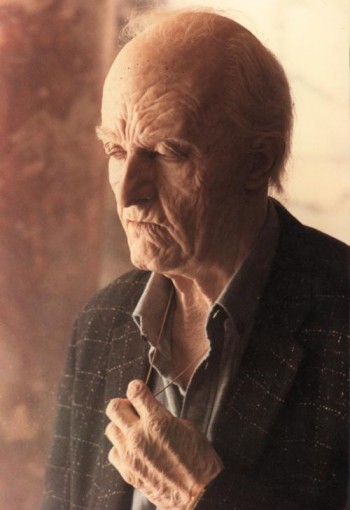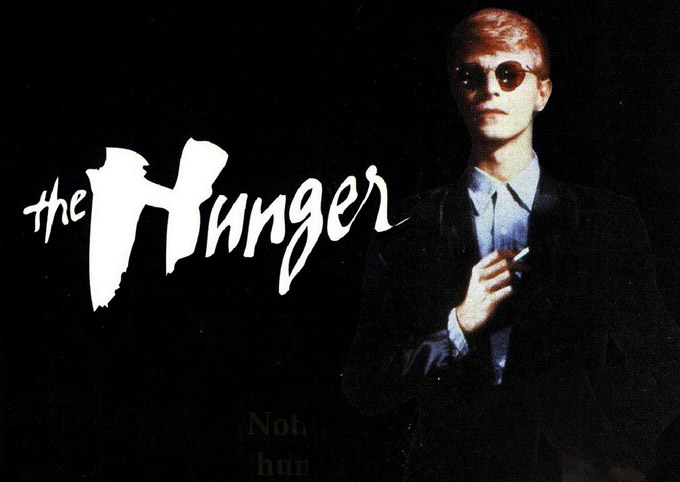Tony Scott, brother of Ridley, made his feature film directorial debut with 1983’s The Hunger. Based on Whitley Strieber’s novel of the same name, this is a stylish, adult tale of a vampire and her consorts. No sparkles here. No fangs. Instead we get Catherine Deneuve and David Bowie, two preternatural beauties in their own right, as a vampire power couple on the decline. Panned by many critics upon its initial release, the years have turned The Hunger into a cult classic. Where else can you find David Bowie, Bauhaus, bare breasts, blood, and monkeys all in one place?
And that’s just the opening six minutes.
While not as meta as his role in The Man Who Fell to Earth and not as regarded with nostalgic glee as his part in Labyrinth, The Hunger is still required viewing for fans of David Bowie. Especially fans of early 80s goth music. When we first meet John and Miriam Blaylock, they are cruising a young couple in a punk danceclub as Peter Murphy and his trademark sepulchral voice croons “Bela Lugosi’s Dead” onstage. But the Blaylocks aren’t on the prowl for sex. See the (NSFW) opening below:
An interesting sidenote about the Bauhaus and their connection to David Bowie: Though they are best known for “Bela Legosi’s Dead,” Bauhaus’ best-selling single was their cover of “Ziggy Stardust” in 1982. Tony Scott was a fan of the band and actually wanted lead singer Peter Murphy to be the Blaylock’s first victim, but later decided it was too contrived. The final cut’s focus on Murphy over the rest of the band helped contribute to the split of Bauhaus. Their last record, 1983’s Burning from the Inside, contains the track “King Volcano,” a reference to the lyrics of Bowie’s “Velvet Goldmine.”
The energetic opening promises more than The Hunger can deliver, but it remains one of the cooler entries in the vampire film canon. Vampirism is presented as a genetic mutation passed on through blood transfusions. Miriam is a true vampire out of ancient Egypt. The human lovers she turns are mere hybrids and after a couple of centuries they inexplicably start to age rapidly. This is what happens to John. Desperate, Miriam turns to a beautiful doctor (Susan Sarandon) specializing in progeria for help.
 As John sits in Dr. Sarah Roberts’ waiting room, he begins to look his three hundred years. In an interview with the BBC, Bowie discussed the challenges of acting beneath layers of prosthetics for his aging scene compared to his stage role as John Merrick in The Elephant Man, which was notable for its lack of makeup. Both roles called upon Bowie’s mime training to portray such extreme physical transformations. The special FX are impressive for the time, but not as impressive as Bowie’s real-life inability to show his true age.
As John sits in Dr. Sarah Roberts’ waiting room, he begins to look his three hundred years. In an interview with the BBC, Bowie discussed the challenges of acting beneath layers of prosthetics for his aging scene compared to his stage role as John Merrick in The Elephant Man, which was notable for its lack of makeup. Both roles called upon Bowie’s mime training to portray such extreme physical transformations. The special FX are impressive for the time, but not as impressive as Bowie’s real-life inability to show his true age.
Much to John’s dismay, instead of finding a cure, Miriam finds a replacement in Sarah. Sarah comes under the thrall of Miriam and the two women share a famously erotic love scene. When Sarah finds out that Miriam is a vampire and that her hybrid consorts never die, only lie in coffins as sentient, tortured husks for all eternity, the search for a cure becomes more personal.
Scott, a television commercial director by trade, made a chilly and sexy flop awash in blue tones, plumes of cigarette smoke, and billowing gauze curtains. The director was also adept at misleading marketing. David Bowie was entering the most popular period of his career with the album Let’s Dance, released two weeks before The Hunger hit theaters. The promotional materials featured the rock star prominently, but the movie only features Bowie for half of its running time. Susan Sarandon is the real stand-out performance. (But keep your eyes peeled for Willem Dafoe’s first role as “Second Phone Booth Youth.”)
Critics reviled The Hunger for its head-scratching ending. Bowie himself called it a “funny little piece” and was much more proud of his performance in Merry Christmas, Mr. Lawrence, released later the same year. As for director Tony Scott, he couldn’t get work in Hollywood for over two years. He later went on on to direct True Romance, Domino, and Man on Fire.
The years since have been kinder to The Hunger than they were to Miriam’s lovers and the film is remembered as a time capsule of 80s style excess—with one of cinema’s sexiest sapphic pairings as a bonus. While David Bowie doesn’t appear in the film for as long as one would like, it’s still a fun footnote in a career of creative reinventions.
Theresa DeLucci has been reviewing television on Tor.com for three years. Her coverage includes Battlestar Galactica, Heroes, Lost, and Game of Thrones. Follow her on Twitter @tdelucci










